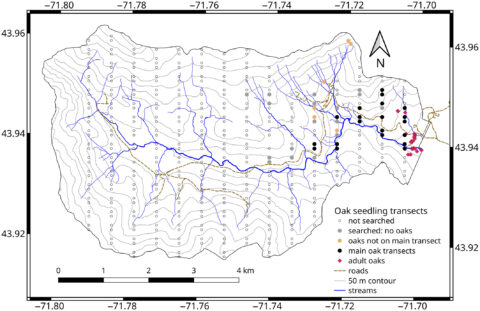Understanding how tree species adapt to changing environments is crucial as global change alters forest ecosystems.
“Multi‐cohort survival of northern red oak seedlings at a northern hardwood forest transition“, published in August 2024, is a long-term study from Cornell University-based Natalie L. Cleavitt, et. al. focused on the northern red oak (Quercus rubra) at the edge of its range in New Hampshire sheds light on the challenges these trees face in expanding their territory.
The research spanned 13 years and tracked over 1,700 seedlings in the Hubbard Brook Experimental Forest (HBEF), a Long-Term Ecological Research (LTER) site with an area of 3160 ha located in the White Mountain National Forest in central New Hampshire.

Map of northern red oak seeding surveys in the Hubbard Brook Experimental Forest, NH. The dots represent the location of the valleywide plots that serve as the center point for oak seedling searches and mapping. The red diamonds denote adult oak trees (N = 31) mapped in the forest. Contour lines are 50 m contours.
The goal was to determine what factors most influence seedling survival and the potential for the species to expand beyond its current boundaries. The results showed that while the overall number of plots occupied by oak seedlings increased, the distance they penetrated into the valley did not change. This suggests a limited ability for the species to move beyond its existing range.
The study found that the year in which a seedling germinated was the most critical factor for its survival. Seedlings from more recent years faced higher mortality rates. Other factors that influenced survival included the density of oak seedlings, the amount of shrub cover, and whether the acorn remained attached to the seedling. Higher survival rates were also observed in seedlings growing at higher elevations within the valley.
Seedling survival from year to year was closely tied to their condition in the previous year, particularly in terms of leaf number and damage. Most seedlings that died did so over the winter, often failing to break bud in the spring. Weather extremes, such as heavy snow in 2019 followed by drought in 2020, also played a significant role in seedling mortality.
Despite these challenges, the net gain in seedling plots and improved survival under certain conditions suggest that northern red oaks might still have pathways for expansion if environmental conditions become more favorable.
Read the open access paper in ESA Ecosphere.
Authors:
Natalie L. Cleavitt, John J. Battles, Jaclyn Hatala Matthes, Sage Wentzell-Brehme
